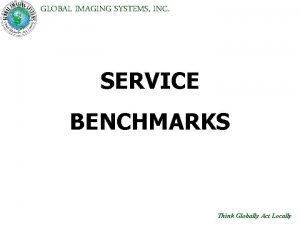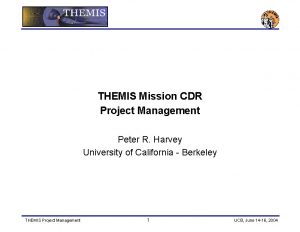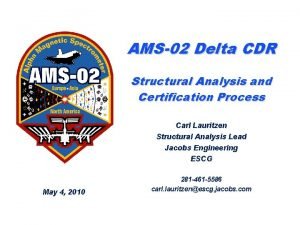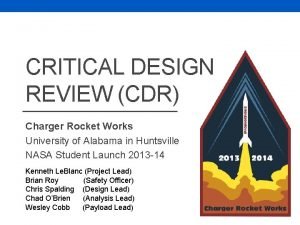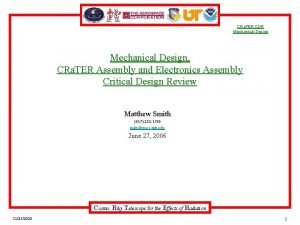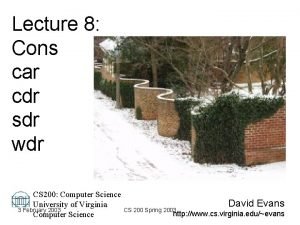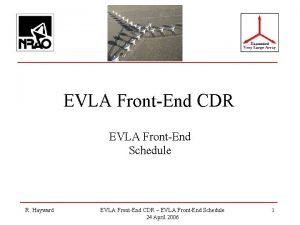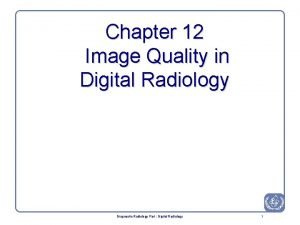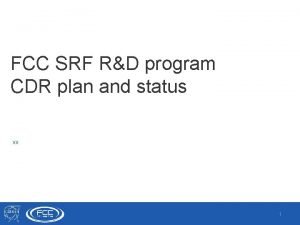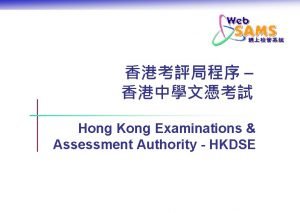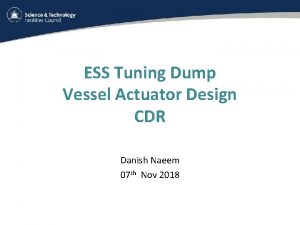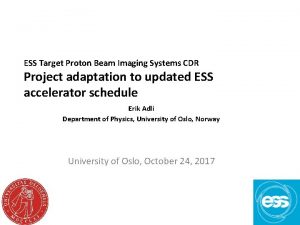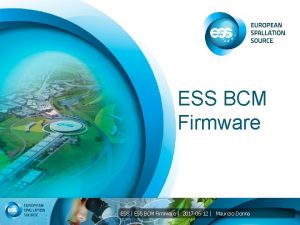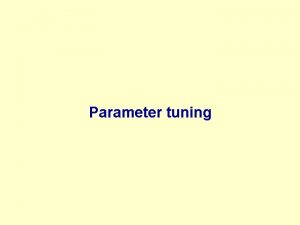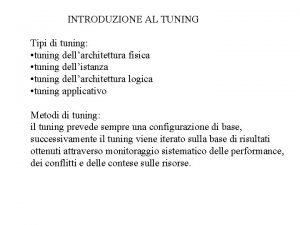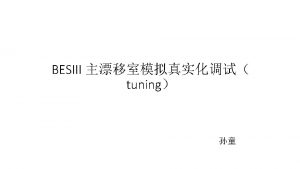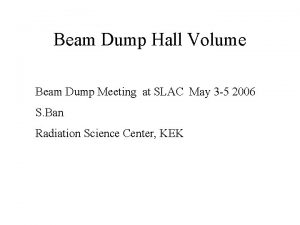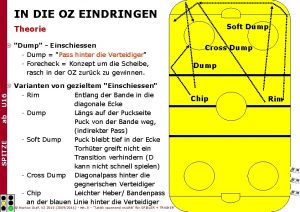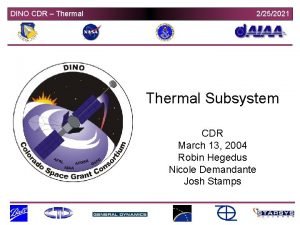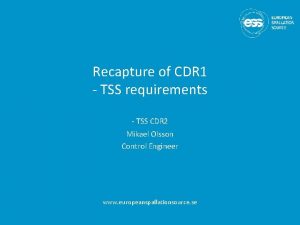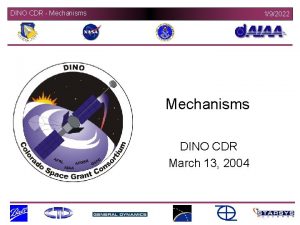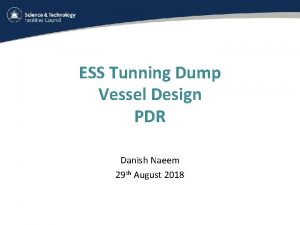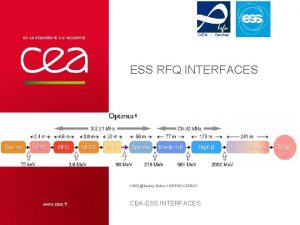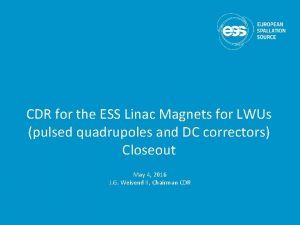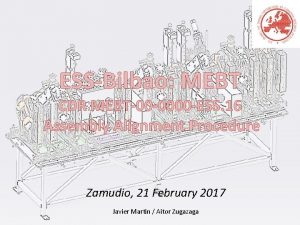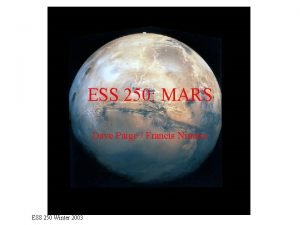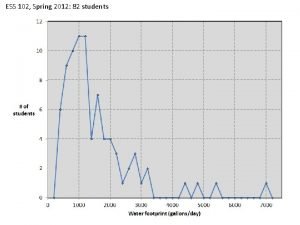ESS Imaging Systems CDR Meeting Tuning Dump Imaging



























- Slides: 27

ESS Imaging Systems CDR Meeting Tuning Dump Imaging: System Design & Radiation Assessment including Interfaces Dr Mark Ibison University of Liverpool Attached to the University of Oslo team 23/10/2017 M G Ibison 1

Outline of Presentation Background and Objectives Design Stages and Concept System Components Optics and Performance Maintenance Issues Radiation Modelling: in-Beam and Decay Interface Definitions Conclusions 23/10/2017 M G Ibison 2

Objectives – Tuning Dump Imaging Objectives 1. Complete all actions arising from Imaging Systems PDR (Sept 2016) 2. Assess radiation levels at Imaging Position in Dump Tunnel • Build FLUKA model of Beam-Line to obtain dose-rates • Select camera for acceptable lifetime • Modify shielding location & design, if necessary 3. Complete optical design for mirror and camera system 4. Confirm that system meets performance requirements 5. Document design for CDR 23/10/2017 M G Ibison 3

Development of Design Principal Stages • • Refine Imaging Vessel configuration Complete Monte-Carlo investigations Consult camera radiosensitivity references Finalise camera locations for radiation dose Address maintenance & access issues Define interfaces/power/data Confirm optical system performance 23/10/2017 M G Ibison 4

Location in Dump Beam-Line • Adjacent Systems – BPMs (4) – aperture monitor (6) – gamma-blocker (7) 23/10/2017 M G Ibison 5

System Environment and Data Flows • decision to locate the cameras in tunnel, close to the beam-line • Image transport simplified, max optical path length < 8 m. BUT • lifetime for standard digital cameras limited in high radiation environment → maintenance access for regular camera changes 23/10/2017 M G Ibison 6

Imaging Concept Dump/Window and Screen Viewing - at same time • Wish to image beam at screen and at dump entrance • Conventional 45° screen for beam profile – but view face-on – Avoid Depth-of-Field issues with large image • Make use of 45° screen as a ‘rear-view’ mirror for the dump 23/10/2017 M G Ibison 7

Imaging Vessel: Evolution of Design A Initial Concept B C D Current Design Ports 1 4 2 3 2, 4 Viewports 1, 3 Actuator Flanges 23/10/2017 M G Ibison 8

Screen Composition Desirable Attributes • Clear diameter > 200 mm, (option up to 230 mm) • Resistance to radiation damage from 2 Ge. V protons • Good mechanical strength for mounting and movement • Vibration-damped against possible beam-pulse induced resonances • Good thermal conductivity, avoid local overheating by beam spot • High MP, to resist beam burning and thermal-spray coating process • Optical flatness across full aperture • Available in thin sheets of thickness 0. 5 – 1. 0 mm • Good adhesion for scintillating coating on front side • Able to accept polishing, or to receive mirror coating on rear side beam 23/10/2017 M G Ibison front beam-facing coating aluminium backing plate silicon wafer substrate mirror coating on the rear 30 mm 200 mm 400 mm 20 mm Total Thickness 650 mm 9

Screen Actuators Screen-in-beam selection permutations Vertical = 2 screens Horizontal = 1 screen Orientation Max Travel required Vertical 600 mm Horizontal 300 mm vertical screens beam Horizontal screen 23/10/2017 M G Ibison 10

Screen Actuators Further Details • • • Supplier Lead Times Expected Lifetime Motors Radiation Issues – Lubrication 23/10/2017 UHV Design (UK) <= 14 weeks (bellows) >= 10, 000 cycles (supplier) Stepper/DC Controllers/Encoders only Special grease advised M G Ibison 11

Other Components Ports, Mirrors and Mounts Viewports Mirror on Mount ‘Benda. Mount’ versatile mirror mounting Mirror platform with vertical motion • viewports on two vessel flanges • DN-200 size available as standard • fused silica avoids radiation darkening • • • 23/10/2017 frames with pairs of vertical posts built on tunnel floor braced at top and mid-height by wall brackets frame mountings for the 1 st and 2 nd mirrors, adjust for alignment mirror on ‘Benda. Mount’ (ESS) secured to platform for vertical motion First mirrors move clear for access to the viewports M G Ibison 12

Optical System Models Ray diagrams Dump/window system • Ray Diagrams camera Screen system camera Plan views 23/10/2017 M G Ibison 13

Performance of Optics Simulated Images Source Bitmap Image Simulation Screen Viewing Dump/ Window Viewing 23/10/2017 M G Ibison 14

Cameras and Housings Selection Preferred standard machine-vision CMOS cameras Support for Gi. G-E data interface adopted on ESS availability, choice of vendor, support, relatively cheap good image quality and off-the-shelf lens options Alternatives – Radiation-hard types Make Lifetime Dose Imaging Dose-Rate Sensor Thermo Scientific 3 x 104 Gy 1 x 103 Gy/hr CID Mirion 3 x 104 Gy/hr Vidicon tube 2 x 106 Gy Location 155 cm high above beam ‘niches’ cut in tunnel walls Screen Dump imaging mirrors supports cameras 23/10/2017 Plan View M G Ibison supports Elevation cameras 15

Maintenance Considerations Cameras • Require changing due to accumulation of radiation damage to CCD pixels • Planned lifetime ~ 1 year or more Degradation with radiation: 0, 25 & 73 Gy † • Easy access from tunnel Screens • Fall-off in image intensity indicates change needed • Probably more efficient to replace 3 screens at once • Access time limited due to the radiation/screen activation 0 Gy 73 Gy †RADIATION TESTS ON SOLID STATE CAMERAS FOR INSTRUMENTATION (CERN, Proc DIPAC 2005) Actuators • Fairly robust, but bellows subject to fatigue • Lifetime estimated >10, 000 operations‡ • Special grease recommended for radiation • Encoder electronics are the most sensitive component 23/10/2017 25 Gy M G Ibison [‡supplier figure] 16

Monte-Carlo Modelling Process FLUKA Data – Inputs & Outputs Input Specification 1077 0. 00552787 1077 0. 00570002 Source particle input 465. 0870056 0. 0258819 877. 8430176 465. 0870056 0. 023271799 888. 0440063 -0. 043026902 0. 00519156 324. 6799927 -0. 044309299 0. 00463426 322. 4060059 SOURCE Routine Modify to suit input and problem - link BEAM, BEAMPOS, Par ticles Geometry Editor Bodies, Regions, Materials FLUKA Executable Geometry Plots External Geometry Viewer* CAD File Output Runtime. Out put Dose-rates to Regions 23/10/2017 Particle tracks M G Ibison Data plots 17

Parameters of the Model Geometry and Beam Parameter Maximum Beam Power Peak Average Current Beam Energy (maximum) Study Time (beam available to Dump) Fraction of Study Time (beam on Dump) Value 12. 5 k. W 6. 3 m. A 2. 0 Ge. V 500 h 0. 5 Notes Slow Tuning Beam (1 Hz) Lower energy also used beam radius 4. 5 cm to fit 10 cm diam beam-pipe Dose vs. Proton Energy (Ge. V) 23/10/2017 0 1 2 M G Ibison 18

Dose from Beam Losses Schematic of Dump and Target Line leg Dog- Dipoles Quadrupoles Tuning Dump Beam losses • • beam directed onto target by dipole magnets in 1 st bend of ‘dog-leg’ particles lost here enter dump tunnel, adding to total dose to cameras earlier modelling work provides input data = (position, direction, energy) per particle build/link customised module SOURCE to read pre-processed particle data into FLUKA Camera Dose from Particle Losses <= 7. 2 Gy per year 23/10/2017 M G Ibison 19

Dose from Beam on Dump Origins of Radiation • In studies ‘on dump’, beam not deflected to target -> enters dump beam-line — Passes through imaging vessel, stopped in dump • Radiation from particles back-scattered through dump entrance — Primary protons and secondaries (e. g. neutrons and gamma-rays) • Scattering in scintillation screen contributes strongly to ambient dose Methodology • • Beam energy taken as 2. 0 Ge. V throughout (pessimistic) Raw FLUKA output gives ENERGY in Ge. V per particle per cm 3 in each ‘region’ Absorbed Dose per particle (in Grays) derived specifically for ‘camera’ regions Tuning Dump Utilization and Average Beam Current gives Dose per Year FLUKA Particle tracks showing scattering by screen Dose (Gy/yr) IN OUT CAMERA 3 45 5 CAMERA 4 15 3 23/10/2017 Camera 3 Camera 4 Imaging Screen OUT Screen IN M G Ibison 20

Camera Location Selection Progressive refinement of camera locations Location Camera: LH RH On tunnel floor, shielded ‘bunker’ 740 940 Below floor, shielded by slab 350 At high level, above vessel 100 39 Moved into tunnel wall ‘niches’ 15 (Doses {typical) in Grays/year are for LH (‘Dump’) and RH (‘Screen’) cameras 74 12

Doses from Decay Screen location FLUKA - Monte-Carlo t=1 h t=72 h Irradiation Profile Analytical Approach 1. Predict Proton Reactions + p+ fluence Apply Bateman equations Derive Nuclides + Activity Comparison 23/10/2017 2. Use Activities + Decay data Look-up g-rays + Geometry Factor Apply Linear Absorption Coefficient Calculate Dose-Rates Decay FLUKA Analytical 1 h 10 -100 51. 3 72 h 1 -10 20. 6 M G Ibison Units: m. Sv/hr 22

Screen Heating Estimation Method Results • imaging screens heated by energy absorbed from beam • calculate the temperature rise from FLUKA Absorbed Dose • exposed area of screen (only), due to a single proton pulse Screen Layer Material Density Layer Thickness Energy Deposited Temp Rise (°C) (cm) (J) RBeam = 1. 0 cm 118. 6 Al 2. 699 0. 002 2. 5 RBeam = 4. 5 cm 5. 9 Substrate Si 2. 329 0. 04 44. 6 7. 8 158. 5 Backing Al 2. 699 0. 02 24. 8 5. 8 117. 6 Coating Al 2 O 3 3. 98 0. 003 5. 4 7. 0 141. 6 Mirror • full thermal analysis not undertaken • no account of heat transfer to surroundings • indicates only peak transient temp, for beam-size (R=4. 5 cm or R=1 cm) 23/10/2017 M G Ibison 23

Interfaces to the Imaging System Responsibilities Vessel design and supply Dump physical configuration Power and signals Dump beam conditions Operational profiles Control software and Alarms STFC ASte. C Group (DL), UK ESS Engineering ESS Beam Instrumentation ESS Accelerator Group ESS Operations ESS ICS Group Interfaces - Physical Vacuum Vessel Design – Procurement – Integration - Test Environment Tunnel + Rack Room Power and Data Supplies to Cameras + Actuators 23/10/2017 M G Ibison 24

Interfaces (2) Parameters and Processes Beam Delivery Beam Size on Dump - Maximum ~350 mm (Fo. V) - Minimum (Heating limited) Operational Profiles ESS Modes of Operation - ‘Studies’ (Days/year) Maintenance ‘Hands-on’ Access Radiation Levels - Cameras/Screens/Actuators - Estimates made 23/10/2017 M G Ibison 25

Planning and Scheduling - Outline Milestone Date Oct 2017 Action Oslo/ESS Jan 2018 STFC Daresbury (DL) April 2018 July 2018 Supplier/STFC Mirror Supports designed Aug 2018 STFC Camera Housings prepared in walls Sept 2018 ESS Dump installed at ESS Beam-line completed (upstream of Vessel) Vessel Integrated to Beam-Line Nov 2018 Bilbao April 2019 ESS May 2019 ESS Mirror Supports installed June 2019 ESS Mirrors fitted, System aligned and tested First Beam-on-Dump July 2019 Oslo Oct 2020 ESS CDR Vessel Specification issued to manufacturer Vessel Delivered to DL Actuators integrated and Tested at DL 23/10/2017 M G Ibison 26

Conclusion Next Steps • Refine design and prepare specifications – Vessel, Actuators, Mirror supports • Define details of imaging screens – Structure/materials/fabrication process • Confirm optical design performance – Camera lenses for minimum aberration • Radiation dose assessment – Maintain model; rerun as necessary 23/10/2017 M G Ibison 27
 Frc control system
Frc control system Un ess meeting
Un ess meeting Global imaging systems inc
Global imaging systems inc For today's meeting
For today's meeting Meeting objective
Meeting objective What is meeting and types of meeting
What is meeting and types of meeting Types of meeting
Types of meeting Pdr cdr project management
Pdr cdr project management Pdr cdr project management
Pdr cdr project management How to find doubling time
How to find doubling time Delta cdr
Delta cdr Cdr
Cdr Cdr design review
Cdr design review Cdr
Cdr Cdr vs cdrw
Cdr vs cdrw Cdr analysis in excel
Cdr analysis in excel Cdr and sdr
Cdr and sdr Cdr
Cdr Restructuring meaning
Restructuring meaning Tor cdr
Tor cdr Cdr
Cdr Ketan computers cdr analysis
Ketan computers cdr analysis Cdr
Cdr Program cdr
Program cdr Cdr
Cdr International arctic buoy program
International arctic buoy program Irac circular rbi
Irac circular rbi Websams helpdesk
Websams helpdesk


